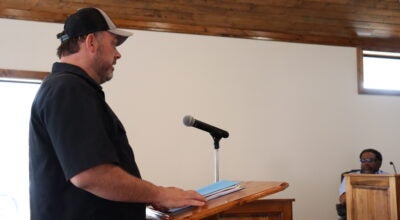Today is April 16, 2021
Published 7:00 am Friday, April 16, 2021
Mushroom Day
Health Benefits of Mushroom Varieties
Low-Calorie
Opt for white buttons: Boasting just 18.5 calories per serving[2], white button mushrooms contain the lowest calories of all mushroom varieties. Additionally, white buttons provide 15 percent of the daily recommended intake of the vitamin B3, niacin. Niacin may promote healthy skin and digestive health.
Bone Health
Say hello to shiitakes: One serving of shiitake mushrooms is an excellent source of copper, offering 40 percent of the recommended daily intake. Copper helps keep bones and nerves healthy.
Immunity
Choose crimini: One serving of crimini mushrooms is an excellent source of selenium, containing 31 percent of the recommended daily intake. Selenium may help the immune system function properly.
Vitamin D
Make room for maitake: One serving of maitake mushrooms contains a whopping 236 percent of the daily recommended intake of vitamin D. Vitamin D may help build and maintain strong bones by helping the body absorb calcium. Additionally, it may support cell growth, neuromuscular and immune function, and help reduce inflammation.
[2] Average serving size is 4-5 mushrooms.
**
Mixed Mushroom Quiche
1 sheet thawed puff pastry
2 tablespoon unsalted butter
3/4 pound fresh mushrooms, sliced (about 3 cups)
3 cloves garlic
1 teaspoon fresh thyme leaves, chopped
1/2 cup chopped chard (or other leafy green)
Salt and pepper
5 eggs
3/4 cup cream or whole milk
3/4 cup shredded mozzarella cheese
1/4 cup shredded Parmesan cheese
Preheat the oven to 325°F. Place a 9-inch deep-dish pie plate on your work surface. Unfold the sheet of puff pastry and place it on a cutting board or piece of parchment paper. Use a rolling pin to lightly roll it until it is big enough to fit into the pie plate. Fit the pastry into the pie dish, trimming any edges that hang over the sides of the plate. Crimp the edges, poke a few holes in the bottom using a fork, and set aside.
Melt 2 tablespoons of the butter in a large skillet over medium-high heat. Add the mushrooms, salt, and pepper and cook, stirring occasionally, until they are tender, about 7 minutes. Stir in the garlic thyme and chard, and cook until fragrant, about 1 minute. Turn off the heat and set aside. There should be no excess liquid, but if there is, blot it with a paper towel.
Whisk the eggs and cream together in a large bowl. Scrape the mushroom mixture into the eggs, add the cheese, and whisk to combine. Pour the egg mixture into the prepared pie plate and arrange the filling so the filling is evenly dispersed.
Set the pie plate on a rimmed sheet pan and bake the quiche until the edges of the quiche are firm, the center is set, and the crust is golden brown, about 50 minutes. Cool for 15 minutes before slicing and serving. The quiche is great warm or at room temperature.
For more information and recipes visit https://www.mushroomcouncil.com/
**
Orchid Day
Orchids belong to the plant family Orchidaceae, one of the largest families of flowering plants with at least 25,000 species. Orchids are found throughout the world except Antarctica, from the tropics to montane cloud forests. Many orchids are native to the United States, but the majority grow in the tropics and subtropics. Orchids have long been valued for their beautiful and unique flowers, scents, foliage, and medicinal uses. In fact, vanilla comes from an orchid.
Orchids are either terrestrial (growing on the ground) or epiphytic (growing on other plants, such as a tree), and require mycorrhizal fungi (fungi on their roots) to provide the plant with minerals and carbohydrates. Many orchids have highly specialized pollinator relationships with bees, moths, and other insects. The shape of the orchid flower leads nectar-seeking insects to pick up and drop off pollen as they visit the flower.
Many orchids are commonly available as houseplants and are sold in nurseries and stores across the United States. Most of the orchids sold in the United States and traded internationally are not collected from the wild, but are cultivated, including many U.S. native species. Horticulturists have created more than 100,000 hybrids of orchid.
Orchids are also used in herbal remedies. Native Americans and early settlers dug and dried certain orchid roots for their medicinal properties. Orchids are used in other ancient medicines, such as Chinese traditional medicine.
While many wild orchids are not considered rare, several are naturally rare due to their specialized habitat requirements and small populations. Over-collection of plants from the wild can also cause orchids to become uncommon. Collection in the wild and loss of habitat have led to decline of orchids, both in the United States and abroad. There are many local, national, and global efforts to conserve orchids and their habitat
For more information visit https://www.fws.gov/international/plants/index.html
**
National Healthcare Decisions Day (NHDD) exists to inspire, educate and empower the public and providers about the importance of advance care planning. NHDD is an initiative to encourage patients to express their wishes regarding healthcare and for providers and facilities to respect those wishes, whatever they may be.
NHDD was founded in 2008 by Nathan Kottkamp, a Virginia-based health care lawyer, to provide clear, concise, and consistent information on healthcare decision-making to both the public and providers/facilities through the widespread availability and dissemination of simple, free, and uniform tools (not just forms) to guide the process.
For more information, conversation starters and workbooks visit https://theconversationproject.org/
**
National Donate Life Blue & Green Day
During National Donate Life Blue & Green Day, the public is encouraged to wear blue and green and to engage in sharing the Donate Life message and promoting the importance of registering as an organ, eye and tissue donor.
**
Organ Donation: What’s True or False?
By Ian Carmody, MD
More than 114,000 men, women and children are currently listed on the national transplant waiting list. Unfortunately, there are not enough organ donors registered to give those in need a second chance at life. This is partially because urban legends, misconceptions and inaccuracies about organ donation make some people hesitant to register on the donor list.
If you are on the fence about becoming an organ donor, it’s probably because of one of the myths below. Every 10 minutes, a new name is added to the national transplant waiting list, and while 90% of U.S. adults say they support organ donation only 60% are actually signed up. I hope that by clearing up the confusion around who is eligible to donate and the way the organ donation process works, I can help persuade you to consider becoming an organ donor this year.
If Emergency Room Doctors Know I’m An Organ Donor, They Won’t Work as Hard to Save Me — FALSE
If you are sick or injured and admitted to the hospital, the number one priority is to save your life. Organ donation can only be considered after brain death has been declared by a physician. Many states have adopted legislation allowing individuals to legally designate their wish to be a donor should brain death occur, although in many states organ procurement organizations also require consent from the donor’s family.
Organs Can Be Bought or Sold on the Black Market — FALSE
This urban legend has been widely circulated over the Internet and has no basis in the reality of organ transplantation. The buying and selling of organs and tissues is illegal, as part of the National Organ Transplant Act. Due to the complexity of transplantation, it would be impossible for this to happen.
Rich and Famous People Can Jump to The Front of the Waiting List Ahead of Everyone Else — FALSE
When you are on the transplant waiting list for a donor organ, what really counts is the severity of your illness, time spent waiting, blood type and other important medical information – not how much money you may have or your celebrity status. There are several factors used to match organs with patients in need. The United Network for Organ Sharing (UNOS), has policies and computerized networks that align transplant candidates with donated organs in ways that save as many lives as possible, along with providing patients with the best chance of long-term wellness. Factors such race, ethnicity, religion, income, insurance or celebrity play absolutely no role in who is prioritized for transplant.
I’m Too Old to Be A Donor — FALSE
People of all ages and medical histories should consider themselves potential donors. Senior citizens in their 90s have been organ donors, and in 2019, 1 out of every 3 people who donated organs was over the age of 50. Your medical condition at the time of death will determine what organs and tissue can be donated. Don’t let your age keep you from saving someone’s life!
My Medical History Means My Organ or Tissue Are Unfit for Donation — FALSE
At the time of death, the appropriate medical professionals will review your medical and social histories to determine whether or not you can be a donor. With recent advances in transplantation, more people than ever before can be donors. It’s best to tell your family your wishes and sign up to be an organ and tissue donor on your driver’s license or an official donor document.
Organ Donation Is Against My Religion — FALSE
All major organized religions approve of organ and tissue donation and consider it an act of charity. The U.S. Government Information on Organ Donation and Transplantation has actually compiled a list of official statements and policies released by religious leaders which you can find here. If you are unsure or uncomfortable though, contact someone at the clergy within your church or place of worship for a consultation.
Becoming an Organ Donor is Complicated and Takes a Lot of Time — FALSE
It’s easy for you to register to be an organ donor! You can register online at ochsner.org/save9. You can also register at your local Office of Motor Vehicles when you are renewing your driver’s license or state identification card.
I Can Save Lives by Becoming an Organ Donor — TRUE!
This is absolutely true – a registered organ donor can save up to nine lives!
A registered organ donor can save up to 9 lives. Learn more at Ochsner.org/save9
Dr. Ian Carmody is an abdominal transplant surgeon. He earned his medical degree from the University of Toronto. Following graduation, he stayed at the University of Toronto to complete his internship and residency. He completed a fellowship in abdominal organ transplantation at UCLA.
Dr. Carmody’s areas of special interest include liver, kidney transplantation, and hepatobiliary surgery. He has been on staff since 2005 and practices at the Ochsner Medical Center main campus. Dr. Carmody is board certified by the American Board of Surgery.



